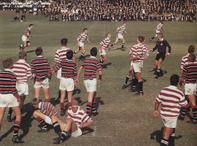Picking up Speed
In 1887, with former head and ‘True Father of Maritzburg College’ Robert Douglas Clark's return, the vigour of the high school improved, and numbers rose meteorically to 51. At his new house in Prince Alfred Street, Clark once again took in boarders.

In August the following year the school moved into the new building (despite its total lack of sanitary facilities), and became known as Pietermaritzburg College. Enrolment stood at a healthy and growing 96 pupils, and within a short time all 60 places reserved for boarders had been filled.
In 1889 the College burst into flower: enrolment stood at a high of 157, with, as Clark remarked, it becoming a 'fashionable craze' (Haw and Frame) to send one's son to Pietermaritzburg College. The prefect system was introduced, under the guidance of senior boy JK Raymond, the first school magazine was printed and the college library opened. When he retired in 1912 Clark donated his extremely valuable book collection to the school.
A cricket field was laid out, soccer was enthusiastically played on a field alongside the river, and the school colours - red, black and white - were instituted by the captain of the school (Dux in 1892) Ernest Holgate. At an Arbor Day ceremony, 1 000 trees were planted in the wild countryside surrounding the school.
Clark also decided on the motto of the school and on the school badge of a crossed shield and assegai, taking both the words and the emblem from the Memorial Tablet to Old Boys who fell in the 'native wars'. Also in that year, among many prominent people to visit the school was Samuel L Clemens, alias Mark Twain.
Three Major Sports
Most senior schools at the time around the 1880s encouraged the playing of one of the three major sports: cricket, rugby or soccer. By 1870 Maritzburg College was playing rugby as its major winter sport. Although for some years the school team had to content itself with playing against local clubs. When the railway line between Durban and Pietermaritzburg was completed in 1880, the school had its first sporting contact with Durban High School in a game of soccer. Maritzburg won the match.
In December 1882, 31 Maritzburg pupils sat the Cambridge Local Examinations for the first time; only 16 passed. Clark laid the responsibility for this poor result squarely at the door of the government, sharply criticising its education policy.
In the latter half of 1883 Robert Clark, in protest at the state of education in the colony, submitted his letter of resignation to the Council of Education. The Council took alarm and persuaded him to reconsider, but the following year Clark announced that he wished to take a year's leave for reasons of ill health. His departure signalled another dip in the fortunes of Maritzburg College and by 1886 there were but 21 boys on the register.